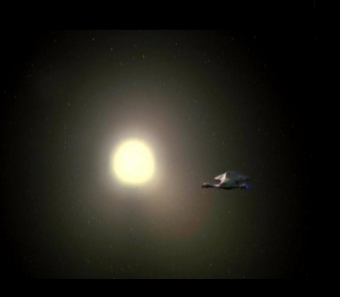
A protostar is a star in the very earliest stage of
development, when interstellar gas is still undergoing gravitational
collapse, and nuclear fusion at the core has just begun. In Star Trek,
the Argolis Cluster is an example of a protostar cluster. During the
Dominion War, Jadzia Dax commanded the Defiant on a mission in the
Argolis Cluster to destroy a Dominion sensor array. She had studied
protostar clusters and would be able to recognize the gravimetric
distortions from them. (DS9: "Behind the Lines") . The USS Defiant
surveyed a cluster of protostars in the Gamma Quadrant in 2373. (DS9:
"Let He Who Is Without Sin...").
The Enterprise NX-01 surveyed a protostar in 2151, one
week before the incident at the Vulcan temple of P'Jem. (ENT: "The
Andorian Incident").
Collapsing protostars sometimes emit E-band bursts.
Protostars were ruled out as a cause for an E-band emission detected on
the USS Enterprise-D in 2367, because there were no protostars within
the sector. (TNG: "The Mind's Eye"). Protostars are often marked by
high levels of magnetascopic interference, which impair sensor
function. While undercover with the Maquis in 2370, Ro Laren used a
protostar in the Topin system as cover to steal medical supplies from
the Enterprise-D. (TNG: "Preemptive Strike")
In 2371, the USS Voyager discovered a protostar with
unusually intense photonic activity. They collected samples of photonic
matter in the hopes of improving their systems, but found that they had
in fact captured photonic lifeforms native to the star. (VOY: "Heroes
and Demons").
A propto-star is the stage in the evolution of a young
star after it has fragmented from a interstellar gas cloud but before
it has collapsed sufficiently for nuclear fusion reactions to begin. It
may last from 100,000 to 10 million years, depending on the mass of the
star. A protostar is surrounded by a dense cocoon of gas and dust that
blocks visible light, but allows through large amounts of far infrared
and microwave radiation.
It is formed by contraction out of the gas of a giant
molecular cloud in the interstellar medium. For a solar-mass star it
lasts about 100,000 years. It starts with a core of increased density
in a molecular cloud and ends with the formation of a T Tauri star,
which then develops into a main sequence star. This is heralded by the
T Tauri wind, a type of super solar wind that marks the change from the
star accreting mass into radiating energy.
|
